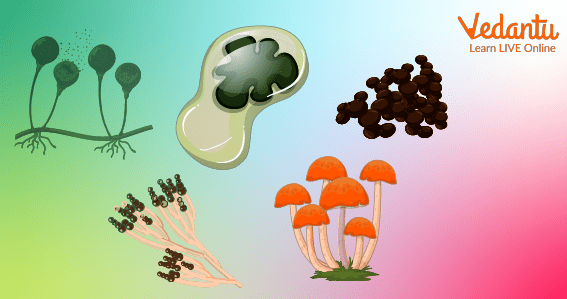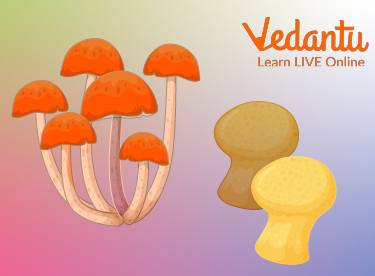




How are Fungi Different from Plants?
Fungi are different from plants because unlike plants, fungi are not able to generate their food by photosynthesis. To survive, they must steal away the energy of other nearby organisms or live off of dead organisms in the ground. They do this by secreting enzymes that break down cells and tissues of other living things to extract nutrients.

Different Types of Fungi
It was once thought that fungi were closely linked with plants and animals on the aeons-long evolutionary tree of life. However, recent research has shown them to be more closely related to bacteria than any other organism on earth. In this article, we will compare some of the differences between fungi and plants and describe some of the specific ways that fungi differ from plants.
Features of Fungi
Some features of fungi are listed below:
One of the features of fungi that we know is that fungi and plants are different because they have different structures (e.g., the structure of cells), organelles (e.g., mitochondria), and genes.
Fungi have specialised cells called hyphae for shooting out a food supply up to 100 times their length, making them much longer than plant roots or shoots.
Fungi have a network of tubes (called mycelia) that have tiny pores called conidiophores. The spores of fungi are not planted spores.
Fungi do not photosynthesize, so they must steal energy from other organisms in the environment. This is done by secreting enzymes into their food source which break down cells and tissues until the desired nutrients are extracted.
One of the features of fungi is that they often make up the majority of a hyphal colony or web (a mycelial net). The hyphae do not form distinct chains, making it hard to see where one hypha ends and another begins because of the overlapping ends (see figure below).
Types of Fungi

Various Types of Fungi
There are five types of fungi. Three of the five are single-celled yeasts and moulds including some non friendly fungus. The remaining two consist of macroscopic mushrooms and puffballs. These two groups have several things in common.
Mushrooms and puffballs are some examples of fungi that differ from plants because they do not have vascular systems or xylem or phloem to conduct nutrients throughout their bodies. They also lack the specialised cells found in plant cells (e.g., vacuoles, lysosomes, plastids).
Fungi can live without water for months, living off of nutrients in their environment. They can even dry out and be revived when water becomes available again. Some examples of fungi include "Wheal Maid", "Tricholoma magnivelare", and "Clitocybe nebularis".
There are over 200,000 known species of fungi including non friendly fungus and more. Since they grow rapidly, they are a major decomposer in nature, recycling nutrients back into the earth after plants and animals die to form a continuous chain of life on earth.
Characteristics of Fungi
The characteristics of fungi are given below:
Fungi have cell walls that are made of chitin, unlike plants, which have cell walls made of cellulose.
Fungi do not have chlorophyll and so cannot photosynthesize. To obtain nutrients, fungi must steal energy from other organisms in the environment or live off of dead organisms in the ground by secreting enzymes into their food source that break down cells and tissues until the desired nutrients are extracted.
They make up the majority of a hyphal colony or web (a mycelial net). The hyphae do not form distinct chains, making it hard to see where one hypha ends and another begins.
Another feature of fungi characteristics is that they have a network of tubes that have tiny holes in them, called conidia. These conidia allow the fungus to shoot out a food supply up to 100 times their length.
Summary
There are a lot of key differences between fungi and plants. Fungi grow from spores while plants grow from seeds. Plants have a tissue layer that absorbs water to bring nutrients to their roots and leaves, which increases their ability to transport nutrients, whereas fungi on the other hand do not have a permanent tissue layer like plants do. We hope you have gained sufficient insights into the differences between fungi and plants and about various characteristics of fungi.
FAQs on Plants vs Fungi - Reasons Why Fungi are Different from Plants
1. What is fungal hyphae?
Fungi have specialised cells or a network called hyphae for shooting out a food supply up to 100 times their length, making them much longer than plant roots or shoots. Fungi also have a network of tubes (called mycelium) that have tiny pores called conidia. Fungi often make up the majority of a hyphal colony or web (a mycelial net). The hyphae do not form distinct chains which make it hard to see where one hypha ends and another begins.
2. What are fungal spores?
The spores of fungi are not planted spores. They do not photosynthesize, and thus take energy from other organisms in the environment. This is done by secreting enzymes into their food source which break down cells and tissues until the desired nutrients are extracted. This means that fungi are much more dependent on the damp environment around them than plants are because they have no chemical method of adapting to what is happening outside their bodies unlike plants, which can produce various compounds like sugars or acids in order to adapt as needed.
3. Are fungi more closely related to plants or animals?
In 1998, scientists discovered that fungi split from animals about 1.538 billion years ago, whereas plants split from animals about 1.547 billion years ago. This means fungi split from animals 9 million years after plants did, in which case fungi are actually more closely related to animals than to plants.





















